Tzu-Heng Huang
Time To Impeach LLM-as-a-Judge: Programs are the Future of Evaluation
Jun 12, 2025Abstract:Large language models (LLMs) are widely used to evaluate the quality of LLM generations and responses, but this leads to significant challenges: high API costs, uncertain reliability, inflexible pipelines, and inherent biases. To address these, we introduce PAJAMA (Program-As-a-Judge for Automated Model Assessment), a new alternative that uses LLMs to synthesize executable judging programs instead of directly scoring responses. These synthesized programs can be stored and run locally, costing orders of magnitude less while providing interpretable, and auditable judging logic that can be easily adapted. Program-based judges mitigate biases, improving judgment consistency by 15.83% and reducing biased responses by 23.7% on average compared to a Qwen2.5-14B-based LLM-as-a-judge. When program judgments are distilled into a model, PAJAMA outperforms LLM-as-a-judge on the challenging CHAT-HARD subset of RewardBench, outperforming metrics by 2.19% on Prometheus and 8.67% on the JudgeLM dataset, all at three orders of magnitude lower cost.
R&B: Domain Regrouping and Data Mixture Balancing for Efficient Foundation Model Training
May 01, 2025
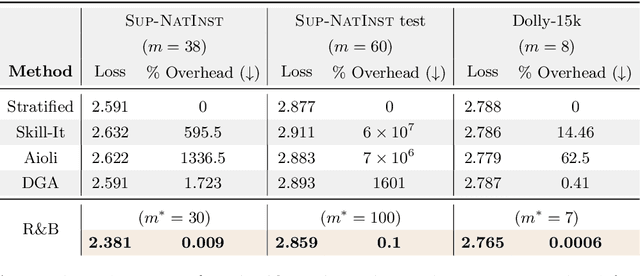
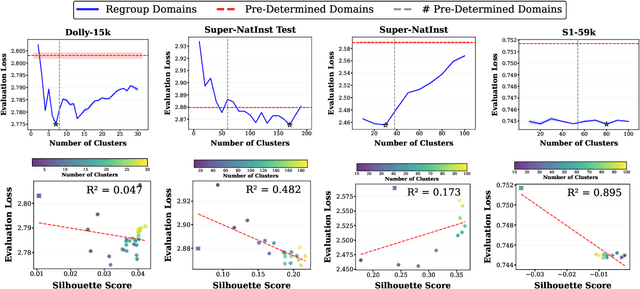
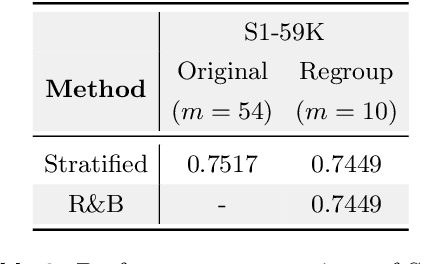
Abstract:Data mixing strategies have successfully reduced the costs involved in training language models. While promising, such methods suffer from two flaws. First, they rely on predetermined data domains (e.g., data sources, task types), which may fail to capture critical semantic nuances, leaving performance on the table. Second, these methods scale with the number of domains in a computationally prohibitive way. We address these challenges via R&B, a framework that re-partitions training data based on semantic similarity (Regroup) to create finer-grained domains, and efficiently optimizes the data composition (Balance) by leveraging a Gram matrix induced by domain gradients obtained throughout training. Unlike prior works, it removes the need for additional compute to obtain evaluation information such as losses or gradients. We analyze this technique under standard regularity conditions and provide theoretical insights that justify R&B's effectiveness compared to non-adaptive mixing approaches. Empirically, we demonstrate the effectiveness of R&B on five diverse datasets ranging from natural language to reasoning and multimodal tasks. With as little as 0.01% additional compute overhead, R&B matches or exceeds the performance of state-of-the-art data mixing strategies.
ScriptoriumWS: A Code Generation Assistant for Weak Supervision
Feb 17, 2025Abstract:Weak supervision is a popular framework for overcoming the labeled data bottleneck: the need to obtain labels for training data. In weak supervision, multiple noisy-but-cheap sources are used to provide guesses of the label and are aggregated to produce high-quality pseudolabels. These sources are often expressed as small programs written by domain experts -- and so are expensive to obtain. Instead, we argue for using code-generation models to act as coding assistants for crafting weak supervision sources. We study prompting strategies to maximize the quality of the generated sources, settling on a multi-tier strategy that incorporates multiple types of information. We explore how to best combine hand-written and generated sources. Using these insights, we introduce ScriptoriumWS, a weak supervision system that, when compared to hand-crafted sources, maintains accuracy and greatly improves coverage.
Evaluating Sample Utility for Data Selection by Mimicking Model Weights
Jan 12, 2025



Abstract:Foundation models rely on large-scale web-crawled datasets, which frequently contain noisy data, biases, and irrelevant content. Existing data selection techniques typically use human heuristics, downstream evaluation datasets, or specialized scoring models, and can overlook samples' utility in the training process. Instead, we propose a new approach, Mimic Score, a data quality metric that uses a pretrained reference model as a guide to assess the usefulness of data samples for training a new model. It relies on the alignment between the gradient of the new model parameters and the vector pointing toward the reference model in weight space. Samples that misalign with this direction are considered low-value and can be filtered out. Motivated by the Mimic score, we develop Grad-Mimic, a data selection framework that identifies and prioritizes useful samples, automating the selection process to create effective filters. Empirically, using Mimic scores to guide model training results in consistent performance gains across six image datasets and enhances the performance of CLIP models. Moreover, Mimic scores and their associated filters improve upon existing filtering methods and offer accurate estimation of dataset quality.
MoRe Fine-Tuning with 10x Fewer Parameters
Aug 30, 2024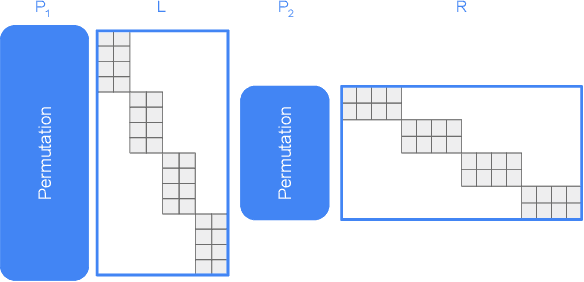

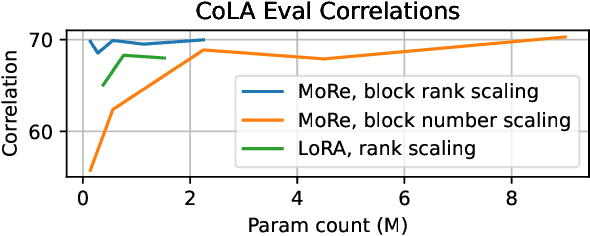

Abstract:Parameter-efficient fine-tuning (PEFT) techniques have unlocked the potential to cheaply and easily specialize large pretrained models. However, the most prominent approaches, like low-rank adapters (LoRA), depend on heuristics or rules-of-thumb for their architectural choices -- potentially limiting their performance for new models and architectures. This limitation suggests that techniques from neural architecture search could be used to obtain optimal adapter architectures, but these are often expensive and difficult to implement. We address this challenge with Monarch Rectangular Fine-tuning (MoRe), a simple framework to search over adapter architectures that relies on the Monarch matrix class. Theoretically, we show that MoRe is more expressive than LoRA. Empirically, our approach is more parameter-efficient and performant than state-of-the-art PEFTs on a range of tasks and models, with as few as 5\% of LoRA's parameters.
Train 'n Trade: Foundations of Parameter Markets
Dec 07, 2023


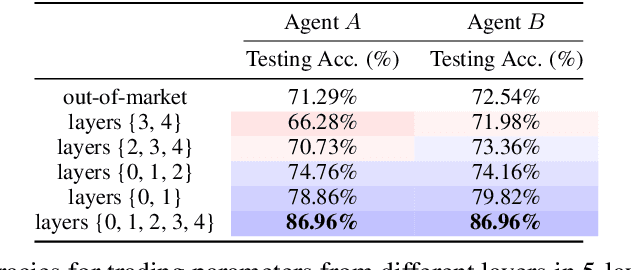
Abstract:Organizations typically train large models individually. This is costly and time-consuming, particularly for large-scale foundation models. Such vertical production is known to be suboptimal. Inspired by this economic insight, we ask whether it is possible to leverage others' expertise by trading the constituent parts in models, i.e., sets of weights, as if they were market commodities. While recent advances in aligning and interpolating models suggest that doing so may be possible, a number of fundamental questions must be answered to create viable parameter markets. In this work, we address these basic questions, propose a framework containing the infrastructure necessary for market operations to take place, study strategies for exchanging parameters, and offer means for agents to monetize parameters. Excitingly, compared to agents who train siloed models from scratch, we show that it is possible to mutually gain by using the market, even in competitive settings. This suggests that the notion of parameter markets may be a useful paradigm for improving large-scale model training in the future.
Geometry-Aware Adaptation for Pretrained Models
Jul 23, 2023Abstract:Machine learning models -- including prominent zero-shot models -- are often trained on datasets whose labels are only a small proportion of a larger label space. Such spaces are commonly equipped with a metric that relates the labels via distances between them. We propose a simple approach to exploit this information to adapt the trained model to reliably predict new classes -- or, in the case of zero-shot prediction, to improve its performance -- without any additional training. Our technique is a drop-in replacement of the standard prediction rule, swapping argmax with the Fr\'echet mean. We provide a comprehensive theoretical analysis for this approach, studying (i) learning-theoretic results trading off label space diameter, sample complexity, and model dimension, (ii) characterizations of the full range of scenarios in which it is possible to predict any unobserved class, and (iii) an optimal active learning-like next class selection procedure to obtain optimal training classes for when it is not possible to predict the entire range of unobserved classes. Empirically, using easily-available external metrics, our proposed approach, Loki, gains up to 29.7% relative improvement over SimCLR on ImageNet and scales to hundreds of thousands of classes. When no such metric is available, Loki can use self-derived metrics from class embeddings and obtains a 10.5% improvement on pretrained zero-shot models such as CLIP.
AutoWS-Bench-101: Benchmarking Automated Weak Supervision with 100 Labels
Aug 30, 2022
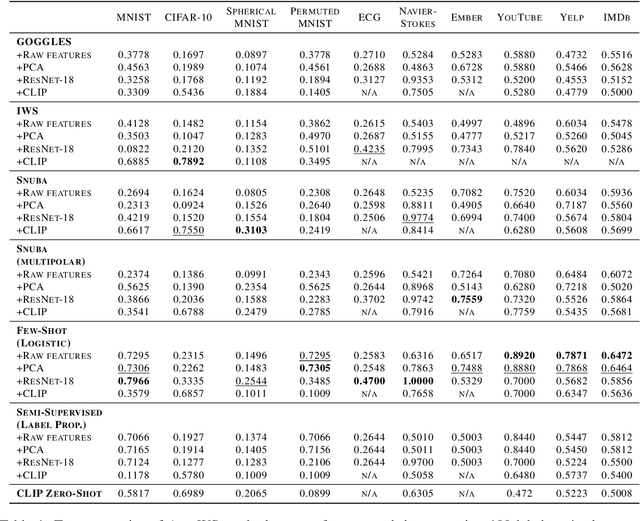

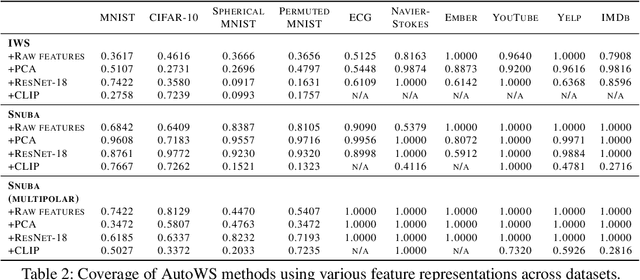
Abstract:Weak supervision (WS) is a powerful method to build labeled datasets for training supervised models in the face of little-to-no labeled data. It replaces hand-labeling data with aggregating multiple noisy-but-cheap label estimates expressed by labeling functions (LFs). While it has been used successfully in many domains, weak supervision's application scope is limited by the difficulty of constructing labeling functions for domains with complex or high-dimensional features. To address this, a handful of methods have proposed automating the LF design process using a small set of ground truth labels. In this work, we introduce AutoWS-Bench-101: a framework for evaluating automated WS (AutoWS) techniques in challenging WS settings -- a set of diverse application domains on which it has been previously difficult or impossible to apply traditional WS techniques. While AutoWS is a promising direction toward expanding the application-scope of WS, the emergence of powerful methods such as zero-shot foundation models reveals the need to understand how AutoWS techniques compare or cooperate with modern zero-shot or few-shot learners. This informs the central question of AutoWS-Bench-101: given an initial set of 100 labels for each task, we ask whether a practitioner should use an AutoWS method to generate additional labels or use some simpler baseline, such as zero-shot predictions from a foundation model or supervised learning. We observe that in many settings, it is necessary for AutoWS methods to incorporate signal from foundation models if they are to outperform simple few-shot baselines, and AutoWS-Bench-101 promotes future research in this direction. We conclude with a thorough ablation study of AutoWS methods.
 Add to Chrome
Add to Chrome Add to Firefox
Add to Firefox Add to Edge
Add to Edge